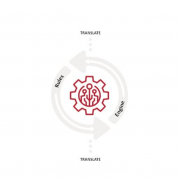NPA ISO 20022: the game is afoot!
Pay.UK’s technical documentation for ISO 20022 implementation heralds serious technical changes for UK payments. For those who need a time shield for ISO migration, we recommend using a flexible solution: a converter.
The introduction of the international ISO 20022 Financial Services standard for payments messaging has brought about significant changes in the banking sector, including in the UK. The recently introduced New Payments Architecture (NPA) will not only make it easier for many companies and clients in the UK to control their transactions but will also open many innovative products and services following ISO 20022 migration.
In early July 2021, Pay.UK released the first set of technical materials for organizations heading for ISO 20022 adoption and facing challenges in transitioning to the Next Generation Standard for UK retail payments. For banks and financial institutions, this is the last call to start working on ISO 20022 changes in their IT architecture.
Requirements are complex, as expected
The ISO 20022 standard is an increasingly used format for payment messages. Based on the XML structure, it is already used by payment systems in over 70 countries. The upcoming ISO 20022 migration will have a huge and profound impact on the data-carrying capacity of payment systems. It will allow richer data and more straight-through processing, which will fundamentally change the way payments are made and financial information is transferred.
The documentation published by Pay.UK is the first set of industry standardization materials to comply with ISO 20022. As expected, it contains a list of technically difficult changes as expected. Although preliminary, it is an important step in standardizing high-value payment data. Based on published market infrastructure guidelines, banks that are not direct participants of CHAPS can begin conducting initial impact assessments of scheduled changes in internal processes and daily operations. Following the adoption of ISO 20022, Pay.UK will require the same changes from its partners as required for financial institutions who are members of the CHAPS system, although in this case the ISO 20022 migration-related deadline is not June 2022, but March 2023. All in hopes that the end customer avoids any negative impact of the changes in cross-border payments.
Pivotal changes require a proper approach
The scope of changes that banks will need to introduce to legacy systems to avoid negative impacts on customers, operations, and market infrastructures is huge. In fact, ISO 20022 migration is broader than any regulatory project in the last 10 years, including SEPA. Therefore, preparation for migration to ISO 20022 will require an experienced IT team, including analysts with in-depth domain knowledge, as explained by my colleagues in “Banking application tests: know-how is king”.
There is some skepticism in the UK as to what opportunities the NPA will eventually bring to financial market infrastructures. Recently, a key stakeholder group raised concerns about the costs, timing, and difficulties of migrating financial market infrastructures to ISO 20022. In February 2021, the payment systems regulator issued a consultation paper seeking the views of the banking industry on the best approach to reduce the risks related to NPA implementation.
There are several ways to upgrade the banking IT architecture to accommodate the ISO 20022 standard in financial messaging. A ready-made solution can be deployed as soon as the software vendor launches it or banks can develop their own solutions in-house. There is also a third option: a financial messaging standards converter as a cost-optimized solution for straight-through processing, with more long-term benefits, and our proprietary application, Payres, can be used as one.
ISO 20022 message standard converter that acts as a time shield
Payres supports back-office applications that do not support the “common language” of ISO 20022, fully or partially. Our payment messaging converter also allows automated processing of cross-border payments exchanged between back-office applications and external networks of financial institutions.
As a Java business application, Payres is lightweight and easy to integrate. This ISO 20022-compliant converter not only “translates” messages, but also enables automated exchange of structured data between the bank’s core system and other systems in line with the new messaging standard.
In addition to the financial messaging standard processing, Payres can be used for advanced reporting purposes or trigger a variety of business rules that take effect in external systems. As a result, information that has so far only been processed in a two-dimensional way is leveraged in a number of dimensions and creates a competitive advantage for your bank.
Need a budget cushion? Say no more!
It may take some time for the NPA to be thoroughly implemented and for the benefits of ISO 20022 to be fully appreciated. The ongoing transition period, with the two formats (MT and MX) running side by side, is a time to redefine the logic of the systems in the IT infrastructure. Only then will you be able to fully reap the benefits of the new standard. For more, see our article “ISO 20022 enhanced data: who will pave the way for new opportunities“.
However, it is possible that all necessary development works required by the end of 20022 will not fit into an annual budget or any single financing period. However, with Payres, you can distribute project costs over several such periods, even over several years. If you need support in preparing your legacy systems for the upcoming changes in payment processing, feel free to get in touch!
If you want to explore Payres in more detail, see our e-book “ISO 20022: a new standard in a complex environment”.

